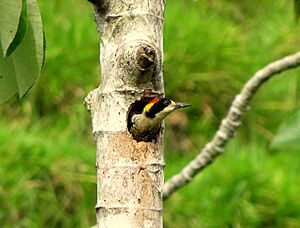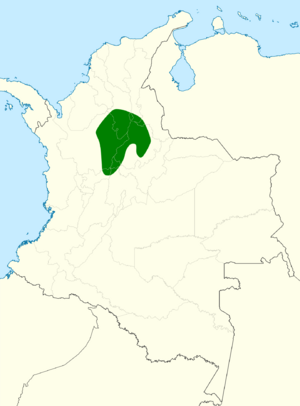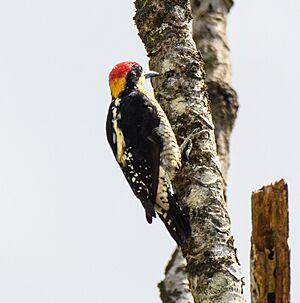Beautiful woodpecker facts for kids
Quick facts for kids Beautiful woodpecker |
|
|---|---|
 |
|
| Conservation status | |
| Scientific classification | |
| Genus: |
Melanerpes
|
| Species: |
pulcher
|
 |
|
| Synonyms | |
|
Tripsurus pulcher |
|
The beautiful woodpecker (Melanerpes pulcher) is a type of bird that lives only in Colombia. It's part of the woodpecker family. This bird is known for its bright colors and unique calls.
Contents
About the Beautiful Woodpecker
For a long time, scientists thought the beautiful woodpecker and the golden-naped woodpecker were the same species. But now, they are considered different birds. The beautiful woodpecker is unique and doesn't have different types or subspecies.
What Does It Look Like?
The beautiful woodpecker is about 17 to 18 centimeters (about 7 inches) long. Both male and female woodpeckers look similar, but their head patterns are a bit different.
- Males have a whitish forehead and a bright red top of the head. Their lower neck is golden yellow.
- Females also have a whitish forehead and a yellow lower neck. But their front part of the head is black, and the back part is red.
Both male and female woodpeckers have black feathers around their eyes. This black color goes down the side of their neck. Their cheeks, throat, and chest are white or pale yellow.
Their upper back and wings are mostly black. Some of their wing feathers have white stripes. Their lower back is white, sometimes with black spots. The tail is brownish-black.
The lower part of their belly has black and white stripes. They also have a red patch in the middle of their belly. Their eyes are very dark brown. The beak is black with a lighter base, and their legs are gray.
Young woodpeckers are not as bright as adults. Their black parts are more brownish. The stripes on their belly are not as clear, and their red belly patch is smaller and more orange.
Where Does It Live?
The beautiful woodpecker lives only in the Magdalena River valley in north-central Colombia. It prefers to live in old, open forests. These can be dry or humid forests.
Sometimes, you can find them in tree plantations. They also live in smaller, broken-up forest areas. These birds usually live at heights between 400 and 1500 meters (about 1,300 to 4,900 feet) above sea level.
How Does It Behave?
Staying in One Place
The beautiful woodpecker stays in the same area all year round. It does not migrate to other places.
What Does It Eat?
This woodpecker usually looks for food high up in the trees. It searches in the very top branches and just below them. It eats insects like wood-boring beetles and termites. Sometimes, it even catches flying insects in the air.
Besides insects, it also eats a lot of fruit. This includes figs, bananas, and fruits from the Cecropia tree.
Breeding Habits
Scientists think the beautiful woodpecker's breeding season is from February or March to June or July. However, not much else is known about how they raise their young.
Sounds and Calls
The most common sound the beautiful woodpecker makes is a loud, squeaky call. It usually has three notes. They also make rattling trills and a churring sound. Both male and female woodpeckers are believed to drum on trees.
Is It in Danger?
The IUCN (International Union for Conservation of Nature) says the beautiful woodpecker is of "Least Concern." This means it is not currently in danger of disappearing.
Even though it lives in a small area, its population seems to be stable. There are no immediate threats that scientists have found. However, the species seems to be somewhat rare and found only in certain spots.
Images for kids




